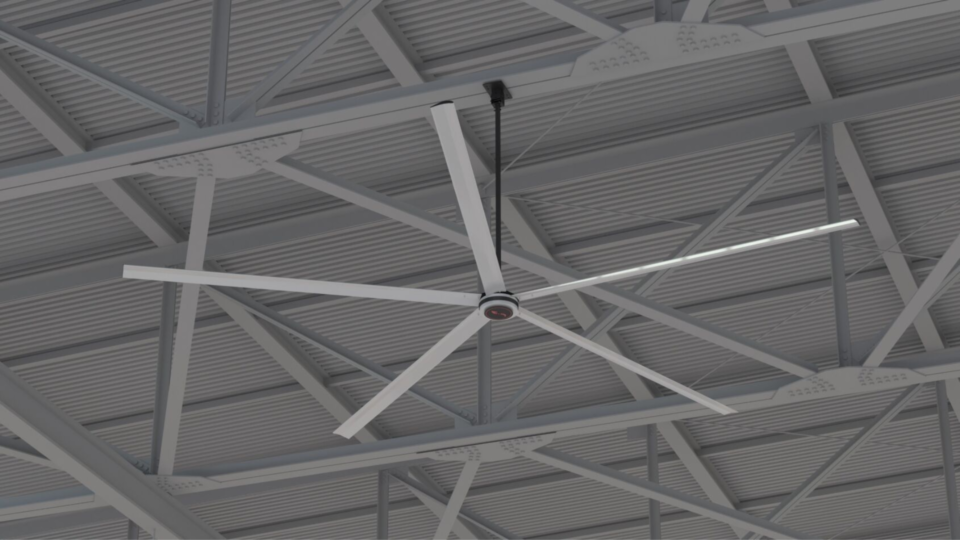A recent survey by Energy Consumers Australia revealed that at least 59% of small business owners are concerned about their energy costs. It doesn’t stop there – small, medium, and large businesses are all affected by the rising energy costs. With costs continuing to rise it’s important to consider all options to reduce energy consumption.
Could you use a ceiling fan to mitigate the effects of the energy crisis?
You could save by investing in large industrial ceiling fans in Australia – don’t miss out on cost savings with minor investments.
How does a ceiling fan work?
Ceiling fans still remain one of the most cost effective methods for temperature control. They are designed to provide comfortable and even temperatures by providing steady airflow. Industrial facility ceiling fans typically have a large blade diameters to facilitate large-volume air circulation.
Here are some of the main features of an industrial ceiling fan:
- Aerodynamic design – ceiling fans have aerodynamic blades tilted at the perfect pitch to provide a large amount of airflow—the aerodynamics help to minimise energy consumption while delivering steady air circulation.
- Powerful motor and drive – a heavy-duty motor provides torque to drive the fan blades quickly and efficiently. The variety of speed controls and settings of the motor allows operators to adjust the speed setting to the space and meet the specific cooling requirements.
- Mounting and installation – industrial ceiling fans are typically mounted to ceilings using brackets and supports. These supports can withstand great stress, allowing them to withstand the fan’s movements. To install a ceiling fan, you must understand the structural integrity of the ceiling.
- Thermal destratification – a ceiling fan provides a solution for thermal stratification. During thermal stratification, the hot air rises towards the ceiling, and the cool air lowers to ground level. The industrial fan redisperses the air for more effective heating and cooling.

How do ceiling fans save money in the summer and winter?
Many people believe that ceiling fans are only useful during the summer. This is because fans are mainly used to provide airflow for cooling, helping to assist the body’s natural evaporative cooling processes.
However, did you know that ceiling fans are useful during the winter too? A ceiling fan can help you maximise your heating systems’ efficiency.
When thermal destratification occurs, hot air rises and moves towards the ceiling, while cool air stays at ground level. This is particularly noticeable in industrial settings as warehouses and factories tend to have extremely high ceilings. Anyone in the room will be closer to ground level and will therefore be in the coldest part of the room. Normal heating would have to then supply the room with more hot air to ensure the room is warm at ground level.
Heating all the air in a large industrial setting is extremely expensive. A much more effective method is to install an energy-saving ceiling fan that circulates the hot air throughout the room, for more even temperature distribution. This is how ceiling fans can help you save money during the winter months.
How can you save energy with ceiling fans?
Using thermal destratification techniques with ceiling fans, you can save up to 30% on your heating costs. Additionally, any occupants in the facility will feel the benefits of your heating and cooling investments more with ceiling fans.
Do’s and don’ts for industrial ceiling fans.
What can you do to get the most out of your industrial ceiling fans? Let’s take a look.
Do’s
Here’s what to do to maximise the efficiency of your ceiling fan:
- Perform regular maintenance – regular maintenance tasks like cleaning the blades, lubricating moving parts, and inspecting motor components will prevent inefficiencies and reduce repair requirements.
- Check structural integrity – before installing your industrial ceiling fan, ensure all parts maintain structural integrity. You should also ensure that the ceiling can withstand the load and that installation is compliant with safety guidelines.
- Adjust speed settings – you should alter the speed settings of your industrial fan to ensure the operation aligns with your ventilation and cooling requirements.
- Seasonal reversal – when the weather gets colder, use the fan’s reverse mode to gently distribute warm air accumulated near the ceiling, enhancing the efficiency of your heating system.
Don’ts
Here’s what to avoid to get the most out of your industrial ceiling fan:
- Overexerting the motor – don’t operate the fan at excessive speeds or without suitable blade adjustments. This will strain the motor, causing wear and tear.
- Ignore unusual noises – an unusual noise can signal mechanical issues with the fan, requiring immediate intervention.
- Compromise safety – do not compromise safety by mounting your ceiling fan in an unsuitable location. Ensure the fan is correctly secured to the ceiling structure.
Need industrial ventilation solutions? Choose Fanquip!
Thermal destratification is a top consideration when saving money during the energy crisis. By ensuring even temperature distribution within your facility, you can provide more efficient heating, saving money and improving comfort.
Are you looking for other helpful ventilation tools? Why not speak to our experts here at Fanquip? We have the expertise and equipment to plan your ventilation strategy from start to finish.
